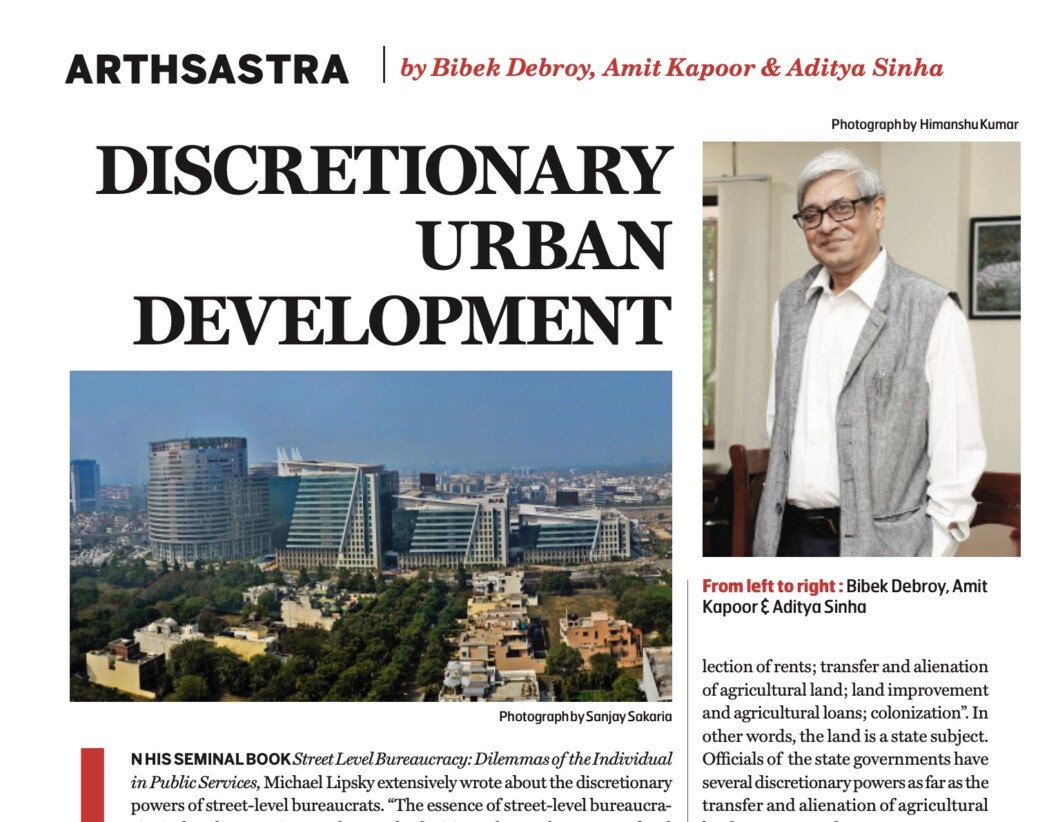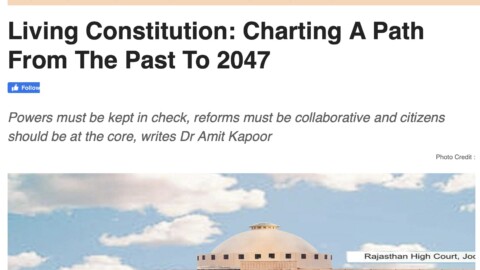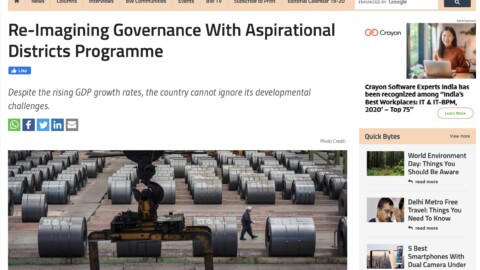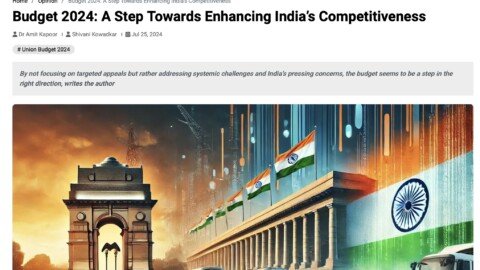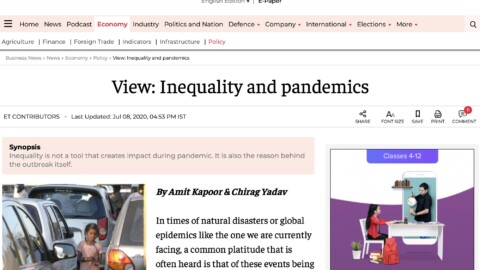Bibek Debroy, Amit Kapoor & Aditya Sinha
In his seminal book “Street Level Bureaucracy: Dilemmas of the Individual in Public Services” Michael Lipsky extensively wrote about the discretionary powers of street-level bureaucrats. “The essence of street-level bureaucracies is that they require people to make decisions about others. Street-level bureaucrats have discretion because the nature of service provision calls for human judgment that cannot be programmed and for which machines cannot substitute”. For Lipsky, the decisions made by these “over-burdened” bureaucrats “ad-hoc policy adaptations that impacted people’s lives”. However, if one looks at the non-street level bureaucracy and, for that matter, the political executive in the state, the exercise of discretionary powers has not always been for good. Discretionary powers can sometimes be very detrimental to both the ease of doing business and the ease of living. Urbanization in India has also been held hostage by discretionary powers, whether the street-level bureaucrats or the state government.
For instance, in the 1990s, the state government of Tamil Nadu created the Tamil Nadu Slum Clearance Board (TNSCB) to address the problem of slums in the state’s capital, Chennai. The TNSCB had the discretionary powers to acquire land, demolish slums, and rehabilitate slum dwellers. However, as always, the discretionary powers were not exercised uniformly. Some slums were destroyed without proper provision of rehabilitation, and selective enforcement led to accusations of corruption and partiality. Many slum dwellers were displaced without adequate warning or compensation, and some became homeless as a result.
We have explained in these pages earlier how states fail to notify something like census towns as urban. However, one often doesn’t discuss the urgent need for land reforms. Entry no. 18 of State List of Seventh Schedule of Indian Constitution “18. Land, that is to say, rights in or over land, land tenures including the relation of landlord and tenant, and the collection of rents; transfer and alienation of agricultural land; land improvement and agricultural loans; colonization”. In other words, the land is a state subject. Officials of the state governments have several discretionary powers as far as the transfer and alienation of agricultural land are concerned.
While the demand for land designated as “urban” has been increasing, there are limitations that have affected the availability of land needed for urban expansion. Agricultural land is classified as rural and non-agricultural land is classified as urban, though the distinction is not always clear-cut. Most rural land is owned by individuals, while a significant amount of urban land is controlled by the government. When trying to convert land for commercial and urban development, three main issues arise.
(1) The process of acquiring privately-held rural land may be restricted by the government and can only be done by the state. This can raise concerns over compensation, the validity of agreements, and the dispute resolution process.Unfortunately, the land acquisition laws that India inherited from the colonial rule were stacked against the rights and interests of land owners and those who rely on the land for their livelihoods. The ‘Right to Fair Compensation and Transparency in Land Acquisition, Rehabilitation and Resettlement Act’, 2013 (LARR Act of 2013) has significantly increased the level of compensation available to land owners and also includes provisions for their rehabilitation and resettlement in case of displacement. While this has dramatically benefited landowners and other affected parties, it can be argued that some aspects of the act could potentially hinder the progress of development projects.
(2) The conversion of agricultural land to non-agricultural use is often discretionary and not transparent, creating opportunities for corrupt practices. In 2011, a study by FAO and Transparency International found that around $700 million (about Rs 3,700 crore) is paid annually as a bribe in India for land administration services. The process of change of land use in India can be intricate and prone to bureaucratic lethargy and the absence of clear rules. While the time taken for land use conversion varies from state to state, decision-making in land use change in most states is still hard to understand, with a lack of transparency and accountability.
In most states, the Chief Minister’s office has the veto power on allowing land conversion. At times, the development of a city or land conversion for urban development is the discretion of the Chief Minister. One example of how such discretionary powers can lead to uneven urban development in geographical locations of the same state is that of Gurugram and Faridabad in Haryana. While both cities come under the National Capital Territory, the level of infrastructure development in both cities cannot be compared. Before 1981, Faridabad was more developed than Gurgaon, with a more robust manufacturing sector, fertile agricultural land and higher household income.
Additionally, Faridabad’s economic growth was more robust than Gurgaon’s. However, between 1981 and 2008, both districts underwent significant changes. One of the reasons for this change was the state government’s efforts to ensure that Gurgaon had access to more affordable agricultural land and greater infrastructure investment compared to Faridabad. The private incentives to develop Faridabad were not as strong as in Gurgaon due to a combination of government actions and external factors. Gurgaon’s rapid development was facilitated by bypassing or circumventing normal governance and democratic systems. In contrast, Faridabad’s growth was limited by the status quo.
(3) Even after conversion, the use of land can be restricted, distorting land markets and hindering the free transfer of land. Some states have restrictions on how the converted land can be used, thus micro-managing the decisions of the property owner and seriously hampering infrastructure development. This can limit both urbanization and urban planning.
Apart from this absence of proper land records is also a big concern. NCAER has a Land Records and Services Index (N-LRSI). This index assesses the level of digitalization of land records and registration procedures in India’s states and union territories. As per, N-LRSI 2021, the quality of land records in Punjab, Haryana, Gujarat and Tamil Nadu is not up to the mark. The bad quality of land records contributes towards information asymmetry, thus hindering the free transfer of lands and distorting land markets. To attract investments, states should immediately carry out land reforms. Until land reforms are carried out, urbanization will remain uneven and ad-hoc.
The article was published with Business World on February 11, 2023.
